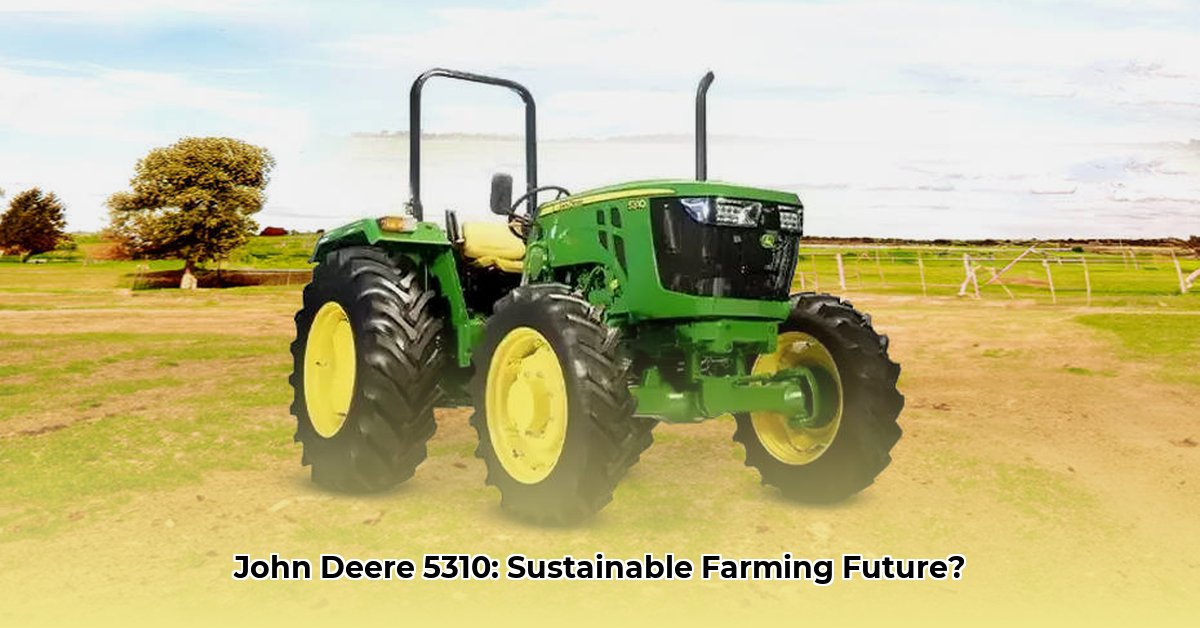
A Sustainability Deep Dive into the John Deere 5310
The John Deere 5310 tractor, a stalwart of farms for decades, presents a compelling case study in sustainable agricultural practices. Its enduring presence raises crucial questions about its long-term environmental impact. This review analyzes its sustainability performance, considering fuel efficiency, lifespan, maintenance, and end-of-life management. We aim to provide a balanced assessment, highlighting both its strengths and limitations in contributing to environmentally responsible farming. For more on John Deere's history, check out this link to collectible tractors.
Performance and Capabilities: Longevity vs. Efficiency
This 64-horsepower workhorse boasts a significant lifting capacity of 3,374 pounds, capable of handling diverse farm tasks. Available with either a 9-speed or 12-speed transmission, it offers operational flexibility. But how does its power translate into sustainable practices? The 5310's exceptional lifespan—many exceeding 6,000 operating hours—is a considerable advantage. Fewer replacements mean reduced manufacturing and associated environmental impact. However, this longevity also means many utilize older technology, potentially less fuel-efficient than modern counterparts. Isn't this a critical trade-off when considering environmental responsibility?
Fuel Efficiency: A Critical Data Gap
Precise fuel consumption data for the 5310 remains elusive. This lack of readily available information is a major obstacle, directly hindering accurate assessment of its carbon footprint. How can farmers effectively gauge their environmental impact without precise fuel consumption figures? This data gap underscores the challenges of evaluating older equipment through a sustainability lens. Further research is crucial.
Maintenance and Lifecycle Costs: The Repair vs. Replace Dilemma
The 5310’s long lifespan presents a double-edged sword. While reducing the frequency of replacements is environmentally beneficial, maintenance and repair costs become significant considerations. Part availability and cost are crucial factors. Does the ease of procuring parts outweigh the environmental benefits of a more fuel-efficient modern tractor? What happens when parts become scarce? Farmers face a complex decision weighing environmental and economic factors when deciding between repair and replacement.
The Environmental Footprint: A Missing Life Cycle Assessment
A comprehensive evaluation of the 5310's environmental impact necessitates a life cycle assessment (LCA). An LCA assesses the entire product lifecycle, from manufacturing to disposal, including fuel consumption, emissions, maintenance needs, and end-of-life management. This detailed analysis is currently missing from publicly available resources, hindering a complete understanding of the 5310's environmental footprint.
Stakeholder Perspectives: Collaborative Sustainability
The sustainability of the John Deere 5310 extends beyond the machine itself; it encompasses its usage and management throughout its lifecycle. A collaborative effort among stakeholders is crucial for effective stewardship.
Key Takeaways:
- The John Deere 5310's extended lifespan significantly reduces the environmental impact associated with frequent replacements.
- The lack of readily available, precise fuel consumption data impedes accurate assessment of its carbon footprint.
- Weighing the repair costs of an older machine against the environmental benefits of a more fuel-efficient model is a key challenge.
- Comprehensive life-cycle analysis is crucial to obtain a complete understanding of the tractor's environmental impact.
- A collaborative approach among farmers, dealers, manufacturers, and policymakers is essential for continuous improvement in sustainable agricultural practices.
How to Assess the Environmental Impact of a John Deere 5310 Tractor
This section provides a practical framework for assessing the environmental impact of a John Deere 5310 tractor, focusing on key areas and mitigation strategies.
1. Fuel Efficiency and Emissions: Data-Driven Assessment
The primary environmental impact stems from diesel fuel combustion, generating greenhouse gases such as CO2, NOx, and PM. Accurate assessment requires data on annual operating hours and fuel consumption rates. Combining this data with engine-specific emission factors allows calculation of the greenhouse gas footprint.
2. Soil Compaction and Degradation: Minimizing Impacts
Heavy machinery can compact soil, reducing water infiltration and aeration. The extent depends on factors including soil type, moisture content, and operational practices. Precision farming techniques, such as GPS-guided steering, mitigate this impact by optimizing field passes.
3. Fertilizer and Pesticide Use: Indirect Impacts
The 5310 plays an indirect role in fertilizer and pesticide application. Sustainable alternatives and precise application significantly reduce environmental consequences. Precision agriculture technologies are particularly beneficial in this regard.
4. Lifecycle Assessment (LCA): The Holistic Approach
A complete assessment requires a full LCA, considering the environmental costs associated with manufacturing, operation, and disposal. This holistic approach provides a comprehensive understanding of the tractor's total environmental impact.
5. Mitigation Strategies: Sustainable Farming Practices
Sustainable farming involves holistic practices that extend beyond equipment choice.
- Optimize fuel use: Proper maintenance, driving techniques, and reduced idling minimize fuel consumption.
- Embrace precision farming: GPS-guided systems optimize fertilizer and pesticide application, reducing waste.
- Promote soil health: Practices such as crop rotation and cover cropping enhance soil health and reduce compaction.
- Explore alternative fuels: Research into biofuels and other alternatives holds long-term potential for emissions reduction.
This comprehensive analysis provides a balanced perspective on utilizing the John Deere 5310 in sustainable farming, underscoring the importance of data, technology, and holistic practices.